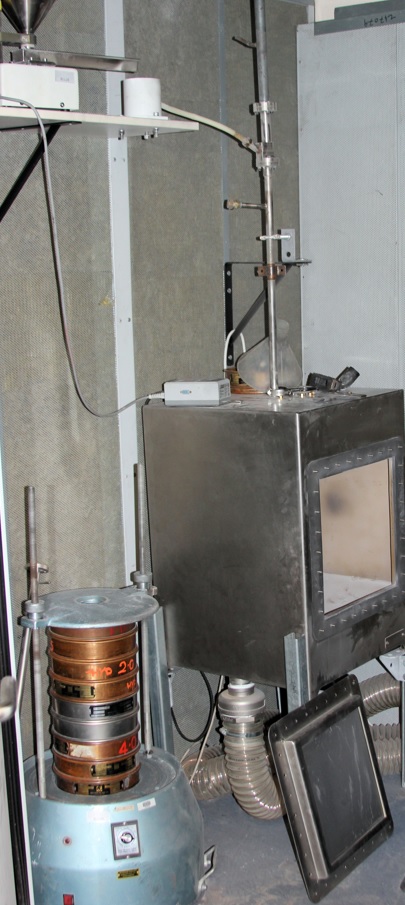Overview
Projects
Specifications
Technical Drawings
The air-sand erosion test rig is a custom-built rig, formerly housed at the Chilworth site and recently moved the Highfield campus, the test chamber is housed in an acoustic chamber as the high velocities employed as they pass the venture create a noise hazard; researchers and consultants are required to wear ear protection during operation.


The rig consists of a compressor which supplies the huge volumes of air needed, this are passed through an air dryer, to remove moisture. This is passed to the test chamber via a flowmeter and a venture. The venture allows the introduction of the erosive particles (erodents), the feed-rate of these is controlled by a vibratory hopper, and these particles are accelerated at the target sample by the air (and a metre long tube). Impact velocities as low as 30 m/s and all the way to 300 m/s can be achieved. The most common erodents employed is silica sand, but alumina, glass beads and even diamond have been employed.
A paper entitled "Design and performance of a high velocity air–sand jet impingement erosion facility" was written when this rig was first build.
Over the years the erosion rig has been used for numerous project from research projects and consultancy jobs to student projects. Initial projects concentrated on super hard materials, such CVD diamond and CVD boron carbides. As well as hard metals, various types of tungsten carbides exploring the influence of grain size and binder concentrations, as well as application type. Many of these coatings finding application in off-shore oil and gas industry where high-velocity fluid flow can led to devastating erosion if particles or even waters are entrained.
More recent projects have focused on the softer coatings, such as polymer coatings for helicopter blades where operation in dusty/desert environments can produce severe erosion. Even more recently erosion of leading edges of wind turbines has become of interest, with the increasing size of wind turbine blades the velocities at the tip is approaching 100 m/s and particle and water droplet erosion is becoming an issue.
Various papers have been produced from the use of this rig and some are listed below with links to DOI locations:
- High velocity erosion of CVD diamond coatings by diamond particles
- Erosion of hard surface coatings for use in offshore gate valves
- Solid particle erosion of CVD diamond coatings
- Solid particle erosion behaviour of CVD boron phosphide coatings
- High energy solid particle erosion mechanisms of superhard CVD coatings
- Solid particle erosion of diamond coatings under non-normal impact angles
- Erosive wear behaviour of thick chemical vapour deposited diamond coatings
- Sand erosion performance of CVD boron carbide coated tungsten carbide
- High velocity solid particle erosion behaviour of CVD boron carbide on tungsten carbide
- Application of diamond to enhance choke valve life in erosive duties
- High velocity sand impact damage on CVD diamond
- The effect of temperature on the erosion of polyurethane coatings for wind turbine leading edge protection
Air-sand erosion rig Specifications:
| Attribute | Range/Value |
|---|---|
| Impact Velocity: | 30 to 300 m/s |
| Impact Angles: |
15°, 30°, 45°, 60°, 90° |
| Erodent type*: |
silica sand, alumina, glass beads, diamond |
| Erodent size**: | sub 100 µm to 2 mm |
* - these are the commonly used erodents, although diamond is a special.
** - this range has been used but it is feasible for large particles (or spheres) to be used.
There are a range of sieves for producing narrower distribution of particle sizes and these include:
- 710 µm
- 500 µm
- 355 µm
- 250 µm
- 180 µm
- 125 µm
- 106 µm
- 63 µm
- 45 µm
- 38 µm
There is a paper entitled "Design and performance of a high velocity air–sand jet impingement erosion facility", that was written when this rig was first build and it can be found at https://doi.org/10.1016/S0043-1648(98)00196-3
The erosion rig can take flat samples of 50 × 50 mm, a technical drawing can be downloaded below. Additionally leading edges of blade samples have been tested, but this would have to be discussed with the facility manager prior to manufacture of samples.